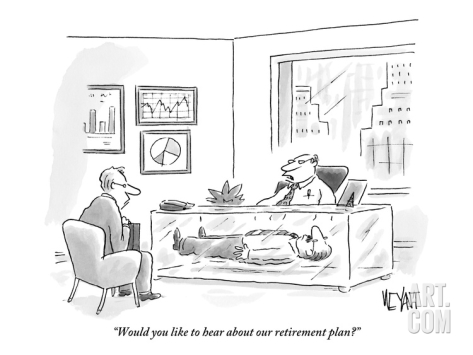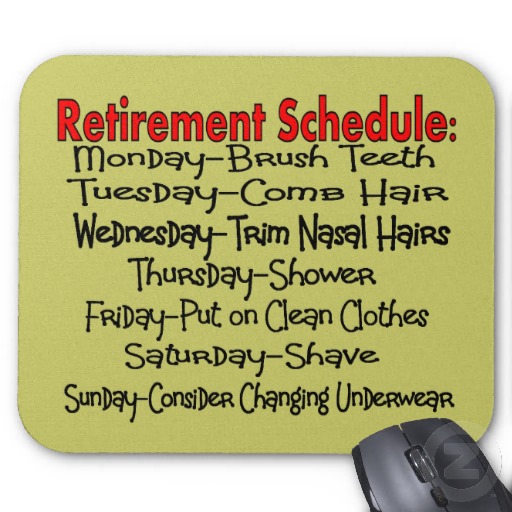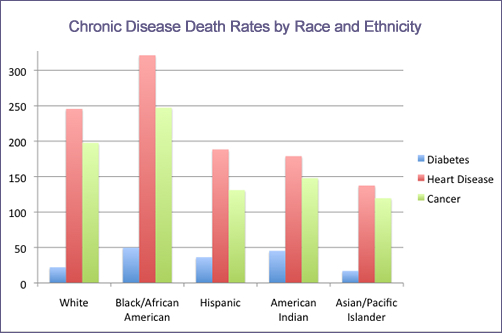
by Mindy Fried | Sep 6, 2015 | aging, applied sociology, connections with people, engaged aging, gender, making choices, research, social science research, SWAN Study, women and health
 I sit opposite Lila [1], the 25-year-old research assistant, in a small room at a satellite office of Mass General Hospital. She is warm and professional, and we have already discovered that she went to college at the same university where I went to graduate school. She took classes with some of my favorite professors, and we may have been in the same room at one point, when I came back to give a talk on campus. This is a nice ice-breaker. But now, in this room, Lila is in the driver’s seat. She has just finished asking me a load of questions about my health, lifestyle, and social networks. I will be there a total of four hours by the time I complete the entire process, which includes a bone density scan and a few other tests they’ve added this year.
I sit opposite Lila [1], the 25-year-old research assistant, in a small room at a satellite office of Mass General Hospital. She is warm and professional, and we have already discovered that she went to college at the same university where I went to graduate school. She took classes with some of my favorite professors, and we may have been in the same room at one point, when I came back to give a talk on campus. This is a nice ice-breaker. But now, in this room, Lila is in the driver’s seat. She has just finished asking me a load of questions about my health, lifestyle, and social networks. I will be there a total of four hours by the time I complete the entire process, which includes a bone density scan and a few other tests they’ve added this year.
 In 1996, right after I completed my Ph.D. in Sociology, I was randomly selected as one of 3,302 women from diverse racial/ethnic backgrounds to participate in this mid-life women’s health study called SWAN – or Study of Women’s Health Across the Nation. The study is following women as we transition through menopause, to better understand the physical, biological, psychological and social changes we experience during this period. SWAN aims to help scientists, health care providers and women “learn how mid-life experiences affect health and quality of life during aging”. [2]
In 1996, right after I completed my Ph.D. in Sociology, I was randomly selected as one of 3,302 women from diverse racial/ethnic backgrounds to participate in this mid-life women’s health study called SWAN – or Study of Women’s Health Across the Nation. The study is following women as we transition through menopause, to better understand the physical, biological, psychological and social changes we experience during this period. SWAN aims to help scientists, health care providers and women “learn how mid-life experiences affect health and quality of life during aging”. [2]
SWAN participants or “subjects” were all between 42 and 52 years old “at baseline” – that, is, when the study began – and we represent seven cities around the country, including my own city of Boston.
When I got the call inviting me to join the SWAN study, I had just completed a lengthy project that involved a lot of interviewing. I welcomed the opportunity to answer someone else’s questions! It also felt great to be a part of important research that had the prospects of influencing medical science. But when I said “yes” to participating in SWAN nearly 20 years ago, I could not have predicted that I would be interviewed by at least 10 or more 20-something research assistants, most of them en route to medical school following this “real-life” experience.
Last year, there was a funding hiatus for the study. I was having a tough year myself and barely noticed that I hadn’t gotten my annual call to set up an appointment. Then a month ago, a letter arrived. SWAN was back in biz, and I’d be getting a call soon! I was thrilled that the study was re-funded in this era of budget cuts for basic science and social science research. I was also feeling grateful that my health was back on track. It struck me that SWAN gave me a regular opportunity to reflect on my life’s circumstances, and to think about how I’m handling growing older, even if it’s only because of a series of questions read to me by a young research assistant whom I’ve just met.
Lila was trained to draw blood, and as she jabs me with the needle, I think, wow, she’s pretty good. We continue to chat, as she measures my waist and hips, clocks how fast I can walk down the narrow hallway, and how long I can balance in a variety of different positions. I’m feeling pretty cocky, until we get to the cognitive test, which they instituted about four years ago. Even though I think my memory is pretty good, being quizzed by a millennial is unnerving. I tell Lila that this test makes me anxious, and she says “yeah, everyone hates it”. That’s only somewhat reassuring, but I appreciate her attempt to normalize my response. Once it’s over – after I spat back a series of numbers and letters in order, and re-told a story about three children in a burning house being saved by a brave fire fighter – I tell myself, “good enough”. That was something my father used to say in moments of stress.
The SWAN Study has taken care to ensure that we are a diverse sample of participants.
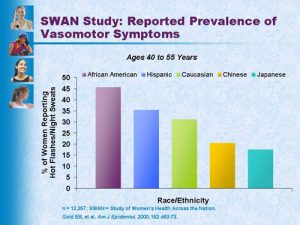
- Prevalence of hot flashes by race/ethnicity
In Boston, researchers over-sampled African-American women, meaning that the study has intentionally included a larger percentage of African-Americans than are represented in the general population. Other cities have ensured that the sample includes large numbers of Chinese, Japanese, and Hispanic women. This oversampling strategy allows researchers to investigate the influence of race and ethnicity on health outcomes of women as we age.
SWAN-affiliated researchers, Drs. Robin Green and Nanette Santoro, found that most symptoms of menopausal women varied by ethnicity. They write,
“Vasomotor symptoms were more prevalent in African-American and Hispanic women and were also more common in women with greater BMI, challenging the widely held belief that obesity is protective against vasomotor symptoms”.
They also found that vaginal dryness was present in 30-40 percent of SWAN participants at baseline, and was most prevalent in Hispanic women. But even among Hispanic women, “symptoms varied by country of origin”. The researchers conclude that “acculturation appears to play a complex role in menopausal symptomatology” and that “ethnicity should be taken into account when interpreting menopausal symptom presentation in women”.
By including an ethnically diverse sample, the SWAN Study is able to compare the experiences of women from varied backgrounds, which has pointed to important differences that should be of great benefit to health care practitioners. Moreover, SWAN researchers provide participants with information about our health, and flag issues we should explore further. For example, I discovered that I had high cholesterol, something that runs in my family. I’m now being monitored by a specialist, who asked me to take a very lose dose of a Statin. And overall, I’m more conscientious about my diet. The upshot is that my cholesterol levels are under control.
Gathering the SWANS…
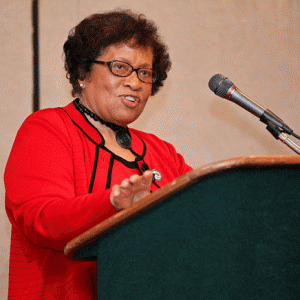
- Jocelyn Elders, former U.S. Surgeon General
In the past couple of decades, the SWAN team held a number of gatherings to bring Boston SWAN “subjects” together. It’s awesome to be in a room with hundreds of women with one thing in common: we are mid-life women who have gone through menopause! What fun to talk about all the crap we are experiencing without feeling judged or worrying that we might be boring someone.
The first gathering I attended offered workshops where “experts” could answer our questions about sleep (like hot flashes keeping us awake) or provide us with alternatives to Hormone Replacement Therapy. One year, SWAN researchers organized an event that featured the brilliant and outspoken Jocelyn Elders, former U.S. Surgeon General who was a lightning rod for speaking her mind, in support of legalizing marijuana, the distribution of contraceptives in schools, and even suggesting that masturbation might be a means of preventing young people from engaging in riskier forms of sexual activity. Sitting in a diverse crowd of mid-life women and cheering for Elders, whom I have admired for years, was positively thrilling.
Lila tells me a little about this year’s gathering, which I unfortunately missed. I learn that one of the Boston-based Principal Investigators, Dr. Joel Finkelstein, is a serious art aficionado and at the last SWAN Study gathering, he showed a series of paintings by an older woman. His message was that we can continue to grow and be creative as we age. When the interview is complete, Lila hands me my gift. In past years, it has been a cup or a small tote bag, marked with the graceful SWAN logo. But this year, it’s a small box, the top graced with a floral design from this artist.
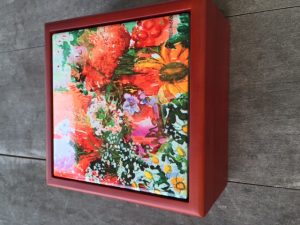
In the abstract of his 2014 application to the National Institutes of Health, Dr. Finkelstein concluded by saying, “SWAN will fill important gaps in understanding the impact of the menopausal transition and mid-life aging on women’s health and functioning in the postmenopausal years. Accordingly, it will provide useful information to guide clinical decisions in mid-life and beyond in women who have diverse life experiences and socioeconomic and racial/ethnic characteristics”.
I’m grateful to be a part of this longitudinal study, to know that the aggregate data being collected reflects a diverse population of women, and that we are collectively contributing to scientific knowledge that can improve the lives of women as we age.
Finally, here’s a great clip from Menopause, the Musical!, just for fun: https://www.youtube.com/watch?v=ndFBFXV3jjs
[1] Fictitious name
[2] The SWAN Study is co-sponsored by the National Institute on Aging (NIA), the National Institute of Nursing Research (NINR), the National Institutes of Health (NIH), Office of Research on Women’s Health, and the National Center for Complementary and Alternative Medicine.
by Mindy Fried | Apr 1, 2015 | adventure, applied sociology, careers, finding work, gender, making choices, program evaluation, race, social science research, sociology
When attempting to transform communities through social policy, it is imperative to not only understand what the social problem is, but also how and why it exists and persists. Trained sociologists have indispensable tools for this type of applied work. – Chantal Hailey
In my last blog post – Choosing Applied Sociology – I referred to a 2013 article in Inside Higher Ed in which Sociologist Roberta Spalter-Roth, from the American Sociological Association, comments that “In sociology, there is close to a perfect match between available jobs and new Ph.D.s”, if you take into account non-academic jobs (https://www.insidehighered.com/news/2013/08/06/sociology-job-market-continues-recover-steadily). She notes that while these “applied” jobs often pay more than university teaching positions, graduates rarely know about them and professors may even discourage their students from entering these professions.
Unfortunately, the majority of Sociology grad students view the tenure-track job market as their only career choice, but there are many Sociologists who have chosen to work in applied settings. The skills gleaned through a Sociology degree are applicable – or dare I say, “marketable” – in a whole host of other venues, including government, corporations, and all sizes of nonprofits, local, state and national. We are researchers, lobbyists, program managers, teachers/trainers, and more.
![]()
I decided to organize a panel on this topic at the annual meeting of Sociologists for Women in Society, held in Washington, DC. And on February, 2015, three distinguished Applied Sociologists from the DC area presented about why they chose this route of practice, what they do and for which populations, and how they incorporate sociological principles into their work, framed by a race, class, gender lens. In this post, one of the speakers, Chantal Hailey, talks about her draw to applied work, which she began as a Sociology student at Howard University. After a number of years doing Applied Sociology, Chantal is now a first year doctoral student at New York University.
Mindy: What interested you in doing applied work?
Chantal: Throughout out my childhood, I lived, attended summer camps and had friends and family who lived in low-income urban neighborhoods. I was able to see how low-quality schools, subpar housing, limited opportunities and violence shaped young peoples’ lives and limited their potential. I had a passion to transform these communities into places where all people could thrive. But on the other hand, I was a nerd. I enjoyed research, history, math and statistics.
During my internship at a research branch of a community development corporation, I discovered that providing statistical trends on health, education, and housing to nonprofits could help them inform how they served low-income communities. I also discovered that the voices of women and people of color were sometimes absent from these discussions. I knew that in order to get a seat at the table, as a black woman, I needed to have the highest credential possible. So I began my academic journey at Howard University (as an) undergraduate in the Sociology department, knowing that my ultimate goal was to complete a doctoral degree in Sociology.
Mindy: Did you know you were learning about Applied Sociology at that point?
Chantal: While I was at Howard, I didn’t know of any distinction between applied and “pure” sociology. I just completed papers on topics that were important to me–public housing, poverty, and education. Urban Institute (UI) kept popping up in my literature reviews and I applied for internship there after my junior year.
Mindy: What did you do when you were at Urban Institute?
Chantal: At Urban Institute (UI), I transformed from an intern to a Research Assistant to a Research Associate. UI’s research is a combination of researcher-generated projects and responses to RFPs (Requests for Proposals). Two of my projects exemplify the type of applied sociology I was able to undertake at UI. The first is the “Long Term Outcomes for Chicago Public Housing Families” project (LTO). LTO is a 10-year longitudinal study of families whose Chicago public housing was demolished or revitalized through the Plan for Transformation. We employed mixed methodology – family surveys; in-depth interviews with heads of household, young adults and children; and administrative data review.
We found that after relocation from distressed public housing developments, families generally lived in better quality housing in safer neighborhoods, but many adults struggled with physical illnesses and youth suffered the consequences of chronic neighborhood violence.
Mindy: What was your role there? What did you do?
Chantal: As a team member in this project, I assisted in developing the survey, helped lead data analysis, generated the young adult interview guides and conducted in-depth interviews with the young people in the study. I also co-led and lead-authored research briefs on housing and neighborhood quality and youth. A research brief is a 15-20 page synopsis of research findings. Unlike most journal articles, there is not a long literature review.
This short article allows us to disseminate the findings to wide audiences. In addition to the standard research brief, we also produced blogs, HUD online journal articles, and radio reports; and briefed the Chicago Housing Authority, Senate committee members, and the press. LTO used sociological methods to understand policy, but intentionally shared this knowledge with wider policy makers and practitioners.
Mindy: You say that trained Sociologists have “indispensable tools” for applied sociology. Can you elaborate on this a bit?
Chantal: Sociology can address a plethora of subject areas that often intersect (i.e. inequality, education, crime and violence, health, etc.), and it unveils the mechanisms behind social problems. A Sociology education trains researchers to look for the hidden transcripts among social groups and interactions, not just the most apparent narrative. It allows for simultaneous macro, meso, and micro analysis to understand multiple contributing factors. And it emphasizes the impact social context has on policies’ implementation and outcomes.
This was especially apparent in the LTO study. We understood that in addition to families’ relocation from public housing, a series of key factors – including proliferating national rates of housing foreclosure, increasing Chicago neighborhood violence, and rising income inequality – also shaped families’ experiences in South Side Chicago neighborhoods.
A Sociology education provides an array of methodological tools that can be tailored to best address research questions (i.e. interviews, focus groups, ethnography, quantitative analysis). It pairs theories of race, class, family structure, etc. to better understand social issues. These analytic and research skills allow us to partner with government, non-profit, and academic agencies to both advance sociological theory and offer practical solutions to social problems.
Mindy: Thank you! And can you provide another example of applied work you’ve done, where you’ve been able to bring your analytic and research skills to the fore?
Chantal: In D.C., I participated in a Community Based Participatory Grant funded by NIH entitled Promoting Adolescent Sexual Safety (PASS). UI, University of California San Diego, D.C. Housing Authority, and D.C. public housing residents collaborated in the PASS project.
This research team – along with a mix of individuals from different racial, class, and professional backgrounds – aimed to develop a program to increase sexual health and decrease sexual violence.
Mindy: How did you use what you were learning as a Sociology student/practitioner?
Chantal: Again, we used sociological methods to conduct this project, including an adult and youth survey, in-depth interviews with community members, participant observations, and focus groups.
Mindy: You said this project was participatory. Can you talk about who was involved? How was it participatory?
Chantal: Through the grant, we developed a community advisory board, a group of 15 residents who participated in creating the PASS program. The interactions between the community advisory board, community practitioners, and the researchers challenged the researchers to not only study educational, class, geographic and racial inequalities, but also to assess how our interactions dismantled or exacerbated power inequities.
Mindy: Earlier, when we spoke, you talked about what it was like to be an African-American researcher who also had a personal understanding of the experience of people you were researching. Can you talk a little about that?
Chantal: As an African American woman on the project with family who lived in D.C., I was personally challenged to both create distance as a researcher and closeness as a fellow black D.C. resident. I often found myself “code-switching” during community meetings, as I communicated with both my co-workers and the community members. Feeling a responsibility to and, often, sympathizing with the desires of the researchers and the residents, I also had to sometimes explain and mediate diverging understandings during conflicts. This closeness and distance dichotomy was also pertinent during data analysis. While my experiences allowed me to recognize and interpret focus group participants’ terminologies and cultural cues, I had to ensure that my sympathies with the community did not cloud my ability to see inconvenient truths.
Mindy: And how did you get what you learned out there to your target audiences?
Chantal: This research project, like most UI projects, focused on dissemination to wider audiences in palatable formats–a community data walk, research briefs, blogs and journal articles.
Mindy: Finally…now you’re a doctoral student at NYU and studying Sociology. How do you see yourself moving forward as a Sociologist? How will you incorporate what you’ve learned into your future practice? (or is that something you’re still figuring out!)
Chantal: As I continue in graduate school at NYU, I aim to crystalize my research identity and trajectory. I have methodological and policy research experience through the Urban Institute, and I am gaining theoretical expertise while completing my doctoral degree. I hope to incorporate these elements into my research and become a conduit between academia, policy makers, and urban communities to make inner city neighborhoods a place where all children can thrive. A mentor once advised me that graduate school is a journey where you begin in one place and end in another. I am tooled with amazing applied experiences and I’m excited to see how my graduate school journey directs my path.
by Mindy Fried | Mar 25, 2015 | applied sociology, gender, program evaluation, race, selecting evaluation researcher, social class, social justice, social science research, working with evaluation researcher
![]()
After working in the policy world in Massachusetts for many years, going back to graduate school in Sociology felt like going to a candy store in the country* every day, where I could read interesting books, have stimulating conversations, learn how to do research, and then write about it. I admired my professors, and I was kind of amazed that their job was to take me seriously and support my development as a scholar. Later, while I was working on my dissertation, I got a job teaching part-time in a local university while a full-time professor went out on leave. It was challenging; it was fun; and it was an incredible opportunity to experiment with pedagogy. I learned that I loved teaching, and over the next two years, got hired to teach a wide range of sociology classes – about families, sex and gender, feminism, work, and women and leadership – at several other Boston universities.
![]()
But the more I learned about the full-time tenure-track teaching world, the more I realized it was just not my thing. First off, I couldn’t imagine “starting over” again at the bottom of the career ladder, with what could be six grueling years of slogging towards tenure. Nor could I imagine the idea of a job for life – the promise of tenure – working with the same folks for the next few decades (apologies to my mythical could-have-been colleagues!). Call me fickle, but I enjoyed changing jobs every few years, having new and varied challenges, and working with a diverse array of people.
Learning on the job
By luck, while I was taking research methods classes, I was offered a small consulting job to evaluate the impact of a well-established training program on its activist participants. Here was an opportunity to put my newfound knowledge to use. Except that no one was teaching how to evaluate social programs in sociology graduate programs! I did have some experience with “program evaluation”. When I was directing a statewide child care project that was federally funded, some guy was hired by the state to evaluate my program. He met with me once at the beginning of the project, and at the end, he wrote a glowing report.
![]()
Every so often, I wondered if he’d be back. In the end, he really had no basis upon which to evaluate the strengths and challenges the project was facing – and believe me, there were plenty. But I wasn’t going to complain if he was phoning it in!
Since I had no idea how to evaluate a program, I hired someone who did, and for the next few years, she trained me and my sociologist friend, Claire, in how to use research skills to evaluate social programs. I never intended to continue doing this “applied” work for the next 20 years, but that is essentially what has happened. When I first started, I wasn’t very good at it, and I thought it was boring. But a couple decades later, I have learned a whole lot about how to do it well, and (luckily) find this work fascinating.
Making a choice to be an applied sociologist
The choice to be an “applied sociologist” is not a rejection or devaluation of academic sociology. It is a choice that is, in part, a function of economic imperatives – a tight job market, especially if you don’t want to move – but also a choice to make a different kind of difference. To impact the social world through organizations that are impacting people: through service, through organizing, and through education and advocacy, in the areas of public health, education, urban planning, climate change, arts and arts education and many more.
I have learned that it makes me happy to use the research and writing skills I learned in graduate school as a tool to help promote social change, through the vehicle of strengthening nonprofit organizations and improving philanthropic decision-making. Once considered the stepchild of the field, applied sociology is now gaining prominence, but largely because the economy has not produced the plethora of academic sociology jobs once predicted.
“Close to a perfect match”
In a 2013 article in Inside Higher Ed, Roberta Spalter-Roth, from the American Sociological Association, commented that “In sociology, there is close to a perfect match between available jobs and new Ph.D.s” (https://www.insidehighered.com/news/2013/08/06/sociology-job-market-continues-recover-steadily). But this is only if you factor in the many government, nonprofit and research analyst jobs out there that require the skills and sociological perspectives learned in graduate school. Spalter-Roth notes that these jobs often pay more than university teaching positions, but graduates rarely know about them and professors may even discourage their students from entering these professions.
This year, my applied sociology friends and I agree that the “applied route” seems to be gaining some traction, with increased interest from universities and professional associations. A number of us have been on a (minor) speaking circuit, talking to graduate students at the request of sociology departments about choosing applied sociology as a career. And this year, the Sociology Department of a major research university, Boston College, hired me to teach a course on Evaluation Research. (Kudos to BC Sociology for recognizing the importance of this avenue for sociologists-in-training!)
Panel at Sociologists for Women in Society: Choosing Applied Sociology (sponsored by the Career Development Committee)
Given this increased interest, and what I believe is a need for sociologists to promote the health and well-being of organizations and communities using research and sociological principles, I organized a panel on this topic at an annual meeting of my favorite national feminist sociology organization, Sociologists for Women in Society.
The panel included three distinguished applied sociologists from the DC area, where the meeting was held, who presented about why they chose this route of practice, what they do and for what populations, and how they incorporate sociological principles into their work, framed by a race, class, gender lens.
The speakers, all based in DC, included Tekisha Everette, a lobbyist for the American Diabetes Association; Andrea Robles, a research analyst at the Corporation for National and Community Service; and Chantal Hailey, who ran evaluation projects at the national Urban Institute and elsewhere, and is currently a sociology doctoral student at NYU. One other panelist, Rita Stephens, was not able to make it because of a blasted snowstorm, but she would have rounded out the panel very nicely as she works at the State Department. The three women spoke to a standing and sitting room only crowd at the meeting, followed by numerous informal conversations, attesting to the fact that there is a hunger for this kind of work.
In my next couple of blog posts, I will allow these amazing women’s words speak for themselves. I hope that their words stimulate a dialogue about the value of and choice to pursue sociology outside of the academy. Based on the remarkable response at this meeting and in classrooms where I talk about applied sociology, my sense is that sociologists want to know about alternatives to working within academia. The words of these speakers inspired me and I hope they inspire you.
“I was interested in doing applied work that could lead to positive social
change. Somehow, it seemed like I wanted to be part of making the world
a better place.”
Sociologist, Andrea Robles
Corporation for National and Community Service
Check out this excellent blog post by Dr Zuleyka Zevallos, Research and Social Media Consultant with Social Science Insights in Australia, called What is Applied Sociology?, published in Sociology at Work: Working for Social Change: http://sociologyatwork.org/about/what-is-applied-sociology/
*Brandeis University, which is actually in the suburb of Waltham, Massachusetts, but looked like the country to this city girl!
by Mindy Fried | Aug 6, 2014 | arts, community, diversity, festival, human connection, music, organizing, porchfest, program evaluation, social science research, sociological imagination
![]()
For a couple of decades, I have been an “applied sociologist”, meaning that my sociology leaves the classroom and situates itself in organizational contexts. There are many ways that applied sociologists “do sociology”. For the most part, my work focuses on evaluating a range of programs and policies to help organizations get stronger and ultimately, bring in more funds so they can continue to do their good work. Applied sociology may be perceived by some as the step child of academic sociology. “Professor” is a far more classy title than Senior Research Associate or even, Wowza Evaluation Research Expert! But academic and applied sociology are equally good options; the choice to pursue one or the other has more to do with the job market, as well as one’s career goals and interests. That said, applied sociologists have fewer institutionalized steps along the career ladder to achieve “success”, and we certainly experience less institutionalized scrutiny. For better or worse, applied sociologists also don’t generally have a “family” of colleagues for life!
A lot of us “applied folks” are happy with our choice. The work is challenging, and the potential to improve programs and policies that improve people’s health, education, incomes and more is satisfying. Many of us also love to teach, but generally when we do, we’re on the lowest rung of the totem pole as adjuncts, with low wages, no benefits and depending on the institution, no status, even if one is a stellar teacher whose students adore you. But unlike adjuncts who are scraping a living together teaching multiple single courses, we may choose to teach a course, without fully depending on this income.
This spring, I discovered another way to put my sociology into action, when I joined with a friend to organize a neighborhood music festival on porches, called “Jamaica Plain Porchfest”(www.jpporchfest.org).
My type of applied sociology had, for the most part, been stuck in a room, or on occasion, at an event or rally. But I felt ready to break out. While I have been evaluating arts-based programs for a number of years, I found that I could bring my sociological eye to designing and implementing this participatory arts-based musical event. Luckily, I was partnered with an old and dear friend who brought the same sensibility and perspective.
Our sociological eyes went into motion from the very beginning of our planning, as we identified the “outcomes” we wanted to achieve for this event. We live in a community that is considered very diverse, in terms of race/ethnicity, class and sexual/gender orientation. But in reality, the community is very divided. There is a “Latin Quarter” which houses Cubans, Dominicans, Puerto Ricans and Central Americans; there are public housing developments that cloister poor people in large high rises; there are new mixed-income housing developments; there are sections of “town” that are entirely working class, and others that are entirely middle class. Our goal was to bring the various strains of the community together – bridging race/ethnicity and class – using music as the vehicle.
The phenomenon of “porchfests” is not new. The first one was organized in Ithaca, New York in 2007, and now there are 20 of them in cities and towns throughout the U.S., including Tucson, Napa Valley, Boulder, Buffalo (my home town!), Salt Lake City and in Somerville, Massachusetts, the porchfest that initially inspired us. From the looks of the incredible photos on each of their porchfest websites, we can see that they are joyous events that build community. From our conversations with the Ithaca and Somerville porchfesters, we also know how successful they are in promoting community bonding, as people come out on the streets to enjoy music together.
In contrast to some of the neighborhoods where other porchfests take place, around half of Jamaica Plain’s residents are people of color, including 25% Latino, 14% African-American, and 4% Asian, and 50% are white. Our commitment was to promote bridging and bonding, by pursuing three strategies: include a diverse range of musicians in terms of their racial/ethnic backgrounds as well as their musical genres; locate and include porches throughout the neighborhood where musicians can play; and engage and bring out diverse audiences. We hoped that these strategies would help to overcome some of the “tri-furcation” or “quadri-furcation” (!) in the ‘hood.
Initially, we created a Facebook page with a call for musicians and porch hosts. But a lot of people don’t go on Facebook, including 27% of online adults who don’t use social media, and another group of people defined as Facebook “resisters”.
So we reached out to local non-profit organizations, some of whom serve youth, others who manage low-income housing, others who coordinate small business activity, and yet others who run programs around maintaining a beautiful, large park in one of the neighborhood’s low-income neighborhoods. We also reached out to students at a highly renowned local music college. We even “scouted” musicians, sometimes at a local park or other venue, as well as musicians we just heard of through friends.
My organizing partner and I started with the idea that we’d do a “pilot” event, with three bands and three porches. But if were to stay true to our goals, we needed to do more than that. Ultimately, we had 60 bands sign up, and enough porches committed so that two bands could play on each porch. We spent hours poring over the mix of bands and porch hosts we would match, focusing on bringing together a mix of people from diverse backgrounds, by race/ethnicity, gender, and where possible, class. In the end, diverse bands and solo musicians shared a stage – aka porch – hosted by a third party who generously offered her/his porch.
We had been informed that one of the other porchfests almost got shut down one year because there were crowds of people roaming the streets, obstructing traffic and trashing neighbor’s lawns. So we created a tiered structure, in which each porch had a “Porch Fun Manager”, each cluster of porches in a particular part of neighborhood had a “Cluster Manager”, and the overall event had two “Network Managers” (me and my partner), who kept an eye on the whole picture. Organizational sociology in action…
While the two of us organized this event, we realized that we were operating within the construct of social institutions that needed to be privy to our plans, offer advice, and inform us of any limitations. So we met with officials from the City, from the police, and from a neighborhood services department that does city permitting. (We were committed to NOT have permits for each porch! We didn’t have the budget and we didn’t want to deal with the bureaucracy.)
![]() And did I mention that we had NO budget whatsoever? This was one of the appeals of the event. Nothing commercial. No “brought to you by”, banners, logos or even food trucks! We received a few in-kind donations: one from a friend, another from the City of Boston which paid for printing colorful maps of the porch routes to be used on the day of the event, and another from a printer who didn’t charge us for printing postcards to announce the event. For many people, the fact that JP Porchfest was commercial-free was a breath of fresh air.
And did I mention that we had NO budget whatsoever? This was one of the appeals of the event. Nothing commercial. No “brought to you by”, banners, logos or even food trucks! We received a few in-kind donations: one from a friend, another from the City of Boston which paid for printing colorful maps of the porch routes to be used on the day of the event, and another from a printer who didn’t charge us for printing postcards to announce the event. For many people, the fact that JP Porchfest was commercial-free was a breath of fresh air.
So how did it go? On the day of the event, we had 7,000-8,000 people roaming throughout the neighborhood listening to music, and hundreds showed up at a local restaurant, Bella Luna Restaurant and Milky Way Café, for an after-party which served $5 all-you-can-eat pizza! Anecdotally, it seemed that everyone loved the event from the audience to the musicians to the porch hosts.
But a good “action sociologist” can’t just leave it there! We needed to evaluate the impact of the event. In order to count the numbers in attendance, we used porchfest stickers, and had intended to count the leftovers to gauge the size of the crowd, except we ran out of stickers in one hour! We consulted an audience researcher on how to calculate the final numbers, and it’s her figures – 7,000-8,000 – that we are citing.
We also distributed very short surveys with a few questions that would help us learn what worked and what didn’t work, as well as to identify the demographics of porchfesters.
Nearly 100% reported that the event was excellent or very good (we’re still working on analyzing this data). In addition, we had two sociology grad students from Brandeis University (my alma mater) traversing the event and interviewing participants about their experience.
![]()
And we queried musicians and porch hosts to provide more detailed feedback on their experiences performing at JP Porchfest, and learned that they made great connections with the other band with whom they shared their porch as well as with their porch hosts. They were pleased that they were able to add people to their mailing lists and increased their CD sales. We also heard that small businesses had increased sales. One of our colleagues and friends from Hyde Square Task Force, a JP youth leadership organization, conducted her own short survey to see if business picked up in the “Latin Quarter”, and interestingly, small shops like the local beauty shop and local rotisserie chicken take-out place increased their business by anywhere from 100-400%!
Finally, we wanted to document the event, creating a team of professional filmmakers who shot the event and will produce two videos. One is a documentary about JP Porchfest that centers on three narratives: a long-time Latina political activist who had just moved into affordable housing and wanted to use porchfest as a way to unite her racially divided neighborhood; a veteran rocker musician who writes songs about JP and is a staple in the ‘hood; and a group of youth leaders from a local non-profit organization who were accompanied by two filmmakers who documented their response to the event and the different types of music. The other is a 5-minute how-to video, which will be accompanied by a training guide that we write, in order to help other communities produce their own porchfests!
My organizing partner and I were initially worried that no one would show up, and then after the event, we worried that we would experience a post-event malaise. But we have been disproven twice! We are now planning JP Porchfest 2015, this time knowing a lot more than what we knew before we started. Soon we’re going to launch a Kickstarter campaign, and Bella Luna/Milky Way has offered us their venue for two fundraisers.
In the end, we determined that we had done a pretty good job, maybe even a really good job! While roughly one-third of our musicians were people of color, we want to increase the diversity of the audience, and we are developing a strategy to do so.
In a follow-up conversation I had with Ayanna Pressley, a brilliant African-American City Councilor who spoke at the event, I lamented that the audience wasn’t as diverse as we wanted it to be, and she told me, “you are acting like a woman!” I was startled. What did she mean? She told me that the event was a great success, but I was focusing on the negative. “We’ll work on that for next year”, she reassured me.
Photos/Video:
1. Woman doing limbo at Nate Smith House, affordable housing for elders. Band was Tempo International Rhythm Section.
2. Sterling Rhyne performing at home of Betsaida Gutierrez, housing activist. Photo credit: Sam Sacks.
3. JP Porchfest banner, created by Hyde Square Task Force Youth Leaders
4. Damn Tall Buildings. Photo credit: Damn Tall Buildings (selfie!)
5. The Amy Hoffman. Photo credit: Jane Akiba
6. Guts and Buttons. Photo credit: Sue Dorfman
7. Cornell Coley and Hyde Square Task Force. Photo credit: Jane Akiba
8. Filmmakers planning Porchfest videos
9. Son of Chris Antonowich, Riding Shot Gun. Photo credit: Sue Dorfman
10. Video, Rick Berlin and Nickel and Dime Band: “I Love My Street”
by Mindy Fried | Apr 20, 2014 | aging, connections with people, engaged aging, family, gender, making choices, retirement, social science research, women and work
re•tire [ri-tahyuh r]
1. to withdraw, or go away or apart, to a place of privacy, shelter, or seclusion: “He retired to his study”.
2. to fall back or retreat in an orderly fashion and according to plan, as from battle, an untenable position, danger, etc.
3. to withdraw or remove oneself: “After announcing the guests, the butler retired”.
4. to withdraw from office, business, or active life, usually because of age: to retire at the age of sixty.
5. retirement or withdrawal, as from worldly matters or the company of others.
One of my friends is passionate about Latin America and travels widely, monitoring elections and writing for an international journal. Her life-long “career” as an energy consultant is gradually shifting to her passionate “avocation”.
A family member who is a therapist decided to significantly pull back on her work hours, but then it didn’t “feel right”. Instead of leaving her practice, she decided to slow down the process, and continues to see clients. She is working fewer hours, spends more time with her children and grandchildren, and has increased her volunteer work.
Another friend had a decades-long successful career as a librarian. As her retirement approached, she was uncertain about what would come next, but stayed open to possibilities. She now works as a volunteer in a number of non-profit organizations, travels, reads, and has time to hang out with friends and former colleagues.
And me? I don’t plan to retire for a long time. First off, even though I’m technically approaching the typical “retirement age”, I like to work because I’d like to think that I’m contributing to making the world a slightly better place, at least in the small piece of the universe I inhabit. Maybe more basic is the fact that, like many people, I can’t afford to retire!
When it comes to major life changes, I like to be fully informed, so I decided to study “retirement narratives”. It’s an informal study that is personally driven by my desire to remain engaged in and satisfied with life when I stop working for pay someday (who knows which day). My study is a pre-emptive strike against loneliness and a concern that as I age, I will be on the periphery, no longer a contributor to the world, no longer a player in daily life…I know this can happen because I’ve seen it happen, and I bet you have too. My observations and intuition have been confirmed by reading a ton of books about aging, in preparation for an aging course I taught at Brandeis University, as well as following the substantial media coverage of issues of aging. My feeling was that my informal study would provide me with an opportunity to better understand this life changing event from a sociological perspective.

My role model for retirement was my father, who didn’t stop working in his job as an English professor until he was around 95 years old. I used to think that his formula – essentially, to never stop working – was how I wanted to live my life. I, too, imagined that I would basically work full-time until I dropped. But now I’m re-thinking my plans. And that’s where my research comes in. My study basically consists of informal “interviews” with friends who are reducing their paid work hours, as well as informal “chats” with acquaintances I run into in random places, like CVS, walking around Jamaica Pond, and on the street. For the people I know and with whom I have regular contact, I plan to follow them over a long period of time, meaning that I want to see what they do and how they adjust for as long as I know them, which could be until I or they die. With these friends, I hear the intimate details of their decision-making. Some of them had full-time jobs in organizations or institutions that provide incentives to retire, and some worried that they might lose their jobs past a certain age. Others work more autonomously as therapists or consultants.
 I want to understand how these friends feel about their paid job as they consider “winding down”: What do they consider will supplant the intense time and commitment they have made to this work? Do they have fears about retirement? Do they have passions they plan to pursue, and plans in place? Do they view retirement as an abyss or a welcome opportunity, neither or both? What will the transition period away from paid work be like? Do they just stop working for pay one day, or do they gradually decrease their hours, and increase the time they spend doing unpaid work or having fun! (imagine that!) How happy are they after retirement, which may include how active they are and how social they are? And lest we forget, how does their health – or the health of their partner – factor into the equation?
I want to understand how these friends feel about their paid job as they consider “winding down”: What do they consider will supplant the intense time and commitment they have made to this work? Do they have fears about retirement? Do they have passions they plan to pursue, and plans in place? Do they view retirement as an abyss or a welcome opportunity, neither or both? What will the transition period away from paid work be like? Do they just stop working for pay one day, or do they gradually decrease their hours, and increase the time they spend doing unpaid work or having fun! (imagine that!) How happy are they after retirement, which may include how active they are and how social they are? And lest we forget, how does their health – or the health of their partner – factor into the equation?
The research questions I employ with my “almost, kinda” friends have a one-two punch. We start by asking one another a few basic questions: “How are you?”, is the starter. Can’t get more basic than that! And then a probing question: “And what have you been up to?” Now this question also seems pretty basic but the reply reveals a lot through their words as well as their body language. If/when they say they’re retired – or just that they left their job of many years – my panoply of probes is unleashed and I ask, “Is it a good thing?” This is a general yes-no question, followed up by “How do you fill your days?” That’s the meat of what I’m looking for.

My informal study has no real parameters. My “sample” is fairly random; it’s not designed with any demographic in mind; I’ll talk to anyone. I’m not keeping track of how many people I’m interviewing, and I’m cool with going with the flow of the conversation, wherever it leads. I’m not discovering anything new, in a broader sense. There’s plenty of literature that argues for continued engagement in life, as one ages. Instead, my study is about getting at the particulars. What do people do as they’re considering retirement? Do they consciously prepare? Once they retire, what are they doing and how do they feel about it?
The issue of retirement has become even more salient because we are living longer. For example, in 2000, the life expectancy in the U.S. for women was 77.6, and for men it was 74.3. In 2010, those numbers had jumped to 79 and 76 respectively. It’s important to note that there is also a racial disparity, as reflected in 2010 figures, with white women projected to live until they are 81.3, and African-American women projected to live until they are 78. For men, the comparison between white and African-American men is 76.5 to 71.8, respectively.
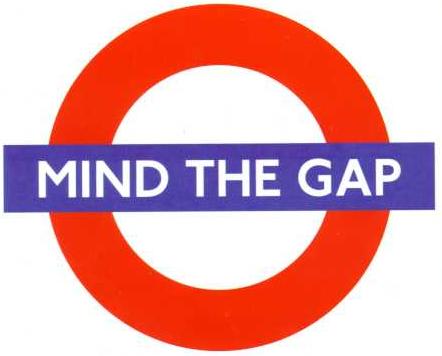
Despite these gender and race disparities, an increase in longevity has resulted in a larger gap in time between official retirement and the point where people stop working for pay altogether. Dr. Mo Wang from the University of Maryland calls this period “post-retirement”, a time when people may choose self-employment, part-time work or temporary jobs. Dr. Jacquelyn B. James, from Boston College’s Sloan Center on Aging and Work (http://www.bc.edu/research/agingandwork/) calls this “transition” period “the “crown of life”, which implies that it is a special time, perhaps less fraught with the demands of one’s “regular” job which may have consumed years or decades of their lives. According to Wang’s research, “retirees who transition from full-time work into a temporary or part-time job experience fewer major diseases and are able to function better day-to-day than people who stop working altogether.”
At the same time, other research doesn’t focus on the impact of paid work; rather, it notes that as people age, those who stay engaged in life, both socially and intellectually, will fare much better than those who retreat, regardless if they are working for pay or doing something else like volunteering, doing unpaid caregiving work, or just about any activity that engages them.
In my effort to amass retirement narratives, I welcome you to tell me yours! It would be great to hear about your journey, whether you’re in the thinking stage or you have started instituting changes in your paid work schedule, or you have left a paid job and are in a next chapter of your life!
Also, just for fun, check out this video of a policy debate between Republican Paul Ryan who wants to increase the retirement age, claiming that the Social Security fund is depleted, and Democrat Debbie Wasserman Schultz, who strongly disagrees: https://www.youtube.com/watch?v=DIrltAkTf38
by Mindy Fried | Feb 12, 2013 | conservatives, ethnicity, G.O.P., gender, health, health care, inequality, progressive policies, race, Republicans, social class, social policy, social science research
The American Enterprise Institute just published a speech by G.O.P. darling and House Majority Leader, Eric Cantor, in which he calls for cutting all federal funds for social science research, insisting that the money would be better spent finding cures to diseases. He uses the story of a child named Katie who battled cancer, and who “just happened” to be sitting in the front row of his audience. “Katie became a part of my congressional office’s family and even interned with us”, he is quoted as saying. “We rooted for her, and prayed for her. Today, she is a bright 12-year-old that is making her own life work despite ongoing challenges…Katie, thank you for being here with us”.
(Please note that the graphic visualizations in this post illustrate the importance of information generated through social science research which have critical implications for policy, e.g., the disproportionate impact of poverty on health outcomes by race/ethnicity) .
I can imagine the emotions in that room, as the audience learns that Katie’s disease is now in remission. Some people of faith in the crowd might be thinking that prayers led to the improvement in her health. But Cantor does not invoke divine intervention. Nor does he totally discount the role that publicly funded resources may have played in helping restore Katie’s health. On the contrary, he cannily declares that there is “an appropriate and necessary role for the federal government to ensure funding for basic medical research. Doing all we can to facilitate medical breakthroughs for people like Katie should be a priority. We can and must do better”.
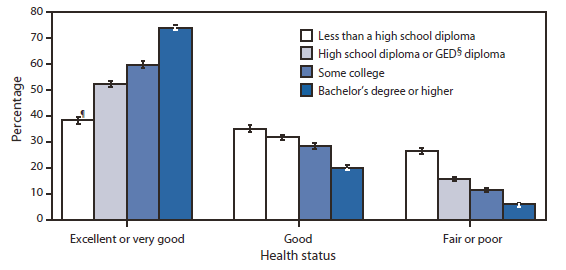
But investing more public funds in research on medical cures, says Cantor, would require cuts in funding for social science research. Presumably, his argument is in the interests of budgetary discipline, because it makes no sense if the goal is to improve people’s health. Less social science research dollars will only weaken our capacity to understand the critical link between the social determinants of disease and health outcomes. We need to ask: Why did Katie get sick? Was she living near a power plant or did she go to a “sick school”? What kinds of services did she have access to? What is Katie’s ethnic/racial background? What is her class background? Because chances are, if Katie is white and middle-class, her access to services are better than if she’s black or Latino and poor.

Cantor trots out the familiar conservative template: We need policies that are based on “self-reliance, faith in the individual, trust in the family and accountability in government”. He declares that the House Majority – aka Republicans – “will pursue an agenda based on a shared vision of creating the conditions for health, happiness, and prosperity for more Americans and their families. And to restrain Washington from interfering in those pursuits”.
But while Cantor frames this as a message of empowerment, his solutions will only reproduce and expand poverty and inequality. Self-reliance is code for slashing government funding. Restraining Washington from interfering with health and prosperity will mean reducing taxes for the rich. And cutting social science research will eliminate needed publicly-funded analyses that provide an essential critique of social and economic policies and their impact.

Cantor’s stance is calculated to appeal to people who are struggling in a tough economy. In his speech, he argues that in America, where two bicycle mechanics, the Wright Brothers, “gave mankind the gift of flight”, we have the power to overcome adversity. “That’s who we are”, he says. Moreover, he argues that throughout history, “children were largely consigned to the same station in life as their parents. But not here. In America, the son of a shoe salesman can grow up to be president. In America, the daughter of a poor single mother can grow up to own her own television network. In America, the grandson of poor immigrants who fled religious persecution in Russia can become the majority leader of the U.S. House of Representatives”.

All I can say is, sign me up, Eric! I’m the grand-daughter of a Russian immigrant, and maybe I’d like to become the majority leader of the U.S. House of Representatives! Honestly? I get weary when I hear about the American dream from another rich, white guy who points to exceptions to the rule, and cynically tries to generalize them.
I just came back from a four-day feminist sociology meeting, sponsored by the organization, Sociologists for Women in Society (SWS) http://www.socwomen.org/web/, in which 250 scholars from around the U.S. and beyond, shared their research about how gender, race and class affect power and status, and how these determinants affect the realities of people’s lives – including their access to quality health care, decent jobs with benefits, high quality education, freedom from discrimination, and safe environments. These are the conditions that Cantor claims should be the right of all Americans, and yet his agenda makes them all less achievable. If Eric Cantor had been at that conference for just one hour, he would have heard about the importance of social science research in understanding systems that reproduce disadvantage for low-income people, immigrants, people of color, same-sex couples and more… But maybe if you preach self-reliance, limited government involvement, and the power of prayer, even a group of brilliant social scientists won’t change your mind.

 I sit opposite Lila [1], the 25-year-old research assistant, in a small room at a satellite office of Mass General Hospital. She is warm and professional, and we have already discovered that she went to college at the same university where I went to graduate school. She took classes with some of my favorite professors, and we may have been in the same room at one point, when I came back to give a talk on campus. This is a nice ice-breaker. But now, in this room, Lila is in the driver’s seat. She has just finished asking me a load of questions about my health, lifestyle, and social networks. I will be there a total of four hours by the time I complete the entire process, which includes a bone density scan and a few other tests they’ve added this year.
I sit opposite Lila [1], the 25-year-old research assistant, in a small room at a satellite office of Mass General Hospital. She is warm and professional, and we have already discovered that she went to college at the same university where I went to graduate school. She took classes with some of my favorite professors, and we may have been in the same room at one point, when I came back to give a talk on campus. This is a nice ice-breaker. But now, in this room, Lila is in the driver’s seat. She has just finished asking me a load of questions about my health, lifestyle, and social networks. I will be there a total of four hours by the time I complete the entire process, which includes a bone density scan and a few other tests they’ve added this year. In 1996, right after I completed my Ph.D. in Sociology, I was randomly selected as one of 3,302 women from diverse racial/ethnic backgrounds to participate in this mid-life women’s health study called SWAN – or Study of Women’s Health Across the Nation. The study is following women as we transition through menopause, to better understand the physical, biological, psychological and social changes we experience during this period. SWAN aims to help scientists, health care providers and women “learn how mid-life experiences affect health and quality of life during aging”. [2]
In 1996, right after I completed my Ph.D. in Sociology, I was randomly selected as one of 3,302 women from diverse racial/ethnic backgrounds to participate in this mid-life women’s health study called SWAN – or Study of Women’s Health Across the Nation. The study is following women as we transition through menopause, to better understand the physical, biological, psychological and social changes we experience during this period. SWAN aims to help scientists, health care providers and women “learn how mid-life experiences affect health and quality of life during aging”. [2]



